The Artful Life: 5 Things Galerie Editors Love This Week - From a must-see art and design exhibition in Bridgehampton to a gorgeous rug collection by Galerie Creative Mind Avram Rusu
August 2, 2023 - Galerie Editors for Galerie Magazine

August 2, 2023 - Galerie Editors for Galerie Magazine
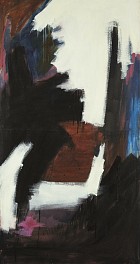
July 21, 2021 - Artsy
Berry Campbell at Intersect Aspen:
Women of Abstract Expressionism
Booth A15
Visit Viewing Room
January 23, 2021 - Berry Campbell
Yvonne Thomas
Portrait, 1956
oil on linen
96.5 x 114.3 cm (38 x 45 in.)
National Gallery of Art, Washington
Gift of Estate of Yvonne Thomas
2020.22.1
© Estate of Yvonne Thomas
Courtesy Berry Campbell Gallery, New York
Yvonne Thomas (1913–2009) is among several important artists from the abstract expressionist era, many of them women, who have been rediscovered in recent years. Portrait (1956), a pivotal work in Thomas’s career, is the first of her paintings to enter the Gallery’s collection and joins an untitled screenprint from 1967.
In 1938 Thomas studied fine art at the Art Students League of New York as well as with Amédée Ozenfant in his atelier. She began to associate with the abstract expressionists, joining discussions at The Club (where she was one of the few members who were women) and at the short-lived school called The Subjects of the Artist. She also studied in Provincetown with Hans Hofmann and exhibited at the renowned Ninth Street Exhibition in 1951. Throughout her work, she combined the gestural language of the New York School painters with sensitive brushstrokes and a lyrical sense of color. In Portrait, the ghostly figurative suggestions and tinted grays evoke an image coming into focus. The painting resonates with works by Judith Godwin, Jack Tworkov, and Frank Lobdell in the Gallery’s collection.
January 23, 2021 - John Hooper for The Wall Street Journal
Collector Christian Levett has filled his Italian palazzo with a world-class assembly of works by female Abstract Expressionists.
Spread over two floors of a palazzo beside the River Arno in Florence, amid the treasures of the Italian Renaissance, is perhaps the world’s largest private collection of art by modern female abstractionists.
Walking down the street you would never know it was there. Even if you knew the name of the collector, former hedge-fund manager Christian Levett, you would have to squint long and hard to find it in the cluster of little brass name plates alongside the palazzo’s massive door. But once across the threshold you are surrounded by paintings by Lee Krasner, Elaine de Kooning, Helen Frankenthaler, Grace Hartigan, Joan Mitchell and other Abstract Expressionists who helped revolutionize art after World War II, turning New York City into the capital of Western culture for the first time.
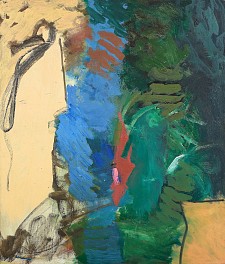
May 23, 2020 - Vittorio Colaizzi for Woman's Art Journal
Writing in 1981 of paintings made between 1955 and 1962, critic Theodore F. Wolff claimed that the work of Abstract Expressionist painter Yvonne Thomas (1913–2009) “reminds us that good painting is good painting regardless of the form it takes.”1 Wolff’s assertion must make the sober and disinterested scholar a little queasy, but it is typical, if somewhat strident, of criticism of Thomas’s work, in that it combines an appeal to quality with an acknowledgement of historical contingency. In this way it demonstrates the problem that Thomas’s work poses for educated viewers. Criticism of the last half century has tended to homogenize and dismiss gestural abstraction as an embodiment of inadvisably idealistic values, and as a foil to or baseline for the performative, sculptural, or photographic work that repudiated or grew from this kind of painting—consider for example the work of Carolee Schneemann (1939–2019). While painting itself currently enjoys wide and varied manifestations, and claims about Thomas’s sheer quality proliferate, a certain familiar aspect to her abstraction, as is evident in Summer Fantasy (1954; Pl. 1), was noticed in published criticism as early as 1956. This did not prevent Dore Ashton from attributing to her “genuinely fresh insights,” nor Donald Judd from excepting her from his nearuniversal condemnation of gestural abstraction with a positive review in 1960. 2
Born Yvonne Navello in Nice, France, in 1913, she moved to Boston with her family in 1926. She showed an interest and aptitude for art from an early age, and following studies at the Cooper Union began a career in commercial art in the 1930s. She married Leonard Thomas in 1938 (they lived in Newport, Rhode Island, during the war), and maintained close ties with the New York art world throughout her life (Fig. 1). She attended the Art Students League in 1940, and studied with Vaclav Vytacil. She also had private lessons with Dimitri Romanovsky (a Russian artist specializing in nudes and portraiture), and attended the Ozenfant School of Art. Nearly every published account of Thomas’s work mentions her participation in the innovative and short-lived painting workshop entitled “The Subjects of the Artists,” which ran from 1948 to 1949 and was initiated but abandoned by Clyfford Still and taken up by Mark Rothko, Robert Motherwell, William Baziotes, and David Hare. Barnett Newman joined in the second year. These sessions were an avenue for the five burgeoning Abstract Expressionists to share with an equal number of interested students, Thomas among them, their incipient methods of free painting, bidden by one’s inclinations in the face of the materials and presumably conditioned by the subconscious mind. Ten years later and throughout her life, this sense of freedom remained in her paintings and works on paper, as a small but expansive gouache shows (Fig. 2; 1959).The aim, as Robert Hobbs and Barbara Cavaliere have shown in their landmark 1977 article, “Against a Newer Laocoon,” was to allow a less literary, less illustrative surrealism to take root. 3
In 1950 she enrolled in one of Hans Hofmann’s summer classes, and in the next decade was included in group exhibitions of artists identified with Abstract Expressionism, including those at New York’s Stable Gallery, from 1953 to 1957. The—only relative—belatedness with which Thomas came to Abstract Expressionism, the stylistic variety she pursued, and the nuanced and revealing critical account that exists, together resonate with contemporary concerns about painting’s viability that are rooted in midcentury abstraction and its reception. Continue Reading
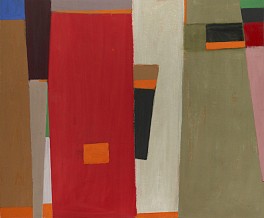
May 7, 2020 - Berry Campbell
Artist's Choice: Interconnected
May 7 - June 7, 2020
View Exhibition
Berry Campbell is pleased to announce Artist’s Choice: Interconnected, an exclusive online exhibition of works from gallery’s inventory chosen by Berry Campbell’s represented contemporary artists. Eric Dever, Judith Godwin, Ken Greenleaf, Jill Nathanson, Ann Purcell, Mike Solomon, Susan Vecsey, James Walsh, Joyce Weinstein, and Frank Wimberley have thoughtfully selected one work from our gallery inventory that they associate with their own creative process and artistic journey. This artist-curated exhibition is an inquiry into the lines of influence and connections within our Berry Campbell artist community. Artist’s Choice: Interconnected launches digitally May 7, 2020.
The choices are sometimes expected, and at other times, surprising. Some artists were inspired by a painting from an artist they had never met, and others paid tribute to old friends or mentors. Judith Godwin recalls good times with her old friend and art dealer, Betty Parsons. James Walsh remembers a painting by Walter Darby Bannard from a 1981 show at Knoedler Gallery. Mike Solomon pays homage to the perseverance of abstract painter and dear friend, Frank Wimberley saying: “The quiet intermingling of his experience, with the purity of painting, gives his abstractions an authenticity and delicacy that is profound to witness.” Ken Greenleaf favorite is Cloistered #5 (1968) by Ida Kohlmeyer, delighting in the pure abstraction. Jill Nathanson picked a color-field forerunner, Dan Christensen. Ann Purcell admitted to being picky but found true inspiration after visiting our Yvonne Thomas show repeatedly. Eric Dever ruminates about Charlotte Park: “Like a favorite poem, novel or even film, a painting can be a touchstone, something one returns to with certain regularity; perhaps a gauge of some kind, beginning with personal happiness on the occasion of discovery and new revelation as our lives unfold.” Joyce Weinstein finds parallels with John Opper. Susan Vecsey loves the “stillness and movement” of Elaine de Kooning’s Six Horses, Blue Wall (1987). No coincidence that Vecsey lives down the road from the Elaine de Kooning house in the Hamptons. Frank Wimberley recalls of Herman Cherry: “He was one of the East End artists who wished to me to succeed.”
ABOUT BERRY CAMPBELL
Christine Berry and Martha Campbell have many parallels in their backgrounds and interests. Both studied art history in college, began their careers in the museum world, and later worked together at a major gallery in midtown Manhattan. Most importantly, however, Berry and Campbell share a curatorial vision.
Both art dealers developed a strong emphasis on research and networking with artists and scholars during their art world years. They decided to work together, opening Berry Campbell Gallery in 2013 in the heart of New York's Chelsea art district, at 530 West 24th Street on the ground floor. In 2015, the gallery expanded, doubling its size with an additional 2,000 square feet of exhibition space.
Highlighting a selection of postwar and contemporary artists, the gallery fulfills an important gap in the art world, revealing a depth within American modernism that is just beginning to be understood, encompassing the many artists who were left behind due to race, gender, or geography-beyond such legendary figures as Pollock and de Kooning. Since its inception, the gallery has been especially instrumental in giving women artists long overdue consideration, an effort that museums have only just begun to take up, such as in the 2016 traveling exhibition, Women of Abstract Expressionism, curated by University of Denver professor Gwen F. Chanzit. This show featured work by Perle Fine and Judith Godwin, both represented by Berry Campbell, along with that of Helen Frankenthaler, Lee Krasner, and Joan Mitchell. In 2019, Berry Campbell's exhibition, Yvonne Thomas: Windows and Variations (Paintings 1963 - 1965) was reviewed by Roberta Smith for the New York Times, in which Smith wrote that Thomas, "... kept her hand in, adding a fresh directness of touch, and the results give her a place in the still-emerging saga of postwar American abstraction.”
In addition to Perle Fine and Judith Godwin, artists whose work is represented by the gallery include Edward Avedisian, Walter Darby Bannard, Stanley Boxer, Dan Christensen, Eric Dever, John Goodyear, Ken Greenleaf, Raymond Hendler, Ida Kohlmeyer, Jill Nathanson, John Opper, Stephen Pace, Charlotte Park, William Perehudoff, Ann Purcell, Mike Solomon, Syd Solomon, Albert Stadler, Yvonne Thomas, Susan Vecsey, James Walsh, Joyce Weinstein, Frank Wimberley, Larry Zox, and Edward Zutrau. The gallery has helped promote many of these artists' careers in museum shows including that of Bannard at the Institute of Contemporary Art, Miami (2018-19); Syd Solomon, in a traveling museum show which culminates at the John and Mable Ringling Museum in Sarasota and has been extended through 2021; Stephen Pace at The McCutchan Art Center/Pace Galleries at the University of Southern Indiana (2018) and at the Provincetown Art Association and Museum (2019); and Vecsey and Mike Solomon at the Greenville County Museum of Art, South Carolina (2017 and 2019, respectively); and Eric Dever at the Suffolk Community College, Riverhead, New York (2020). In an April 3, 2020 New York Times review of Berry Campbell's exhibition of Ida Kohlmeyer's Cloistered paintings, Roberta Smith stated: “These paintings stunningly sum up a moment when Minimalism was giving way to or being complicated by something more emotionally challenging and implicitly feminine and feminist. They could hang in any museum.”
Collaboration is an important aspect of the gallery. With the widened inquiries and understandings that have resulted from their ongoing discussions about the art world canon, the dealers feel a continual sense of excitement in the discoveries of artists and research still to be made.
Berry Campbell is located in the heart of the Chelsea Arts District at 530 West 24th Street, Ground Floor, New York, NY 10011. For further information, contact us at 212.924.2178, info@berrycampbell.com or www.berrycampbell.com.
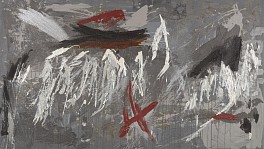
March 30, 2020 - Berry Campbell
Ida Kohlmeyer
VIDEO: Virtual Exhibition Walkthrough
Women of Abstract Expressionism
Inventory Highlights
View Exhibition
Ann Purcell
Upcoming Exhibition: Kali Poems
View Works by Ann Purcell
Judith Godwin
Forbes Magazine: Add to Your list of '5 Women Artists' at These Museums Around The United States
by Chadd Scott
Charlotte Park
Client Testimonial:
"Extremely gratifying to see Paul Kasmin Gallery's eye-opening summer show, Painters of the East End reviewed by Erin Kimmel in this month's Art in America . And smiled extra wide that AbEx talent Charlotte Park is written up in the same paragraph as — and holds her own with— Joan Mitchell. 'Park's virtuosic oil and crayon compositions (ca. 1965 and 1967) feature dendrite-like configurations in a palette of bright pinks, yellows and blues that appear frozen mid twist.' Ten years ago Christine Berry, owner of one of the most engaging and provocative galleries in Chelsea, Berry Campbell, thankfully introduced me to the work of Charlotte Park, who died in 2010 at age 92 in Montauk, where she lived and painted. She was the wife of artist James Brooks, supporting his career at the expense of her own, and dear friends and neighbors of Jackson Pollock and Lee Krasner."
-Adam Beckerman
View Works by Charlotte Park
Yvonne Thomas
Eazel Interactive Exhibition | Yvonne Thomas: Windows and Variations (1963-1965)
Susan Vecsey
blue.
Nassau County Museum of Art, Roslyn Harbor, New York
View Works by Susan Vecsey
Jill Nathanson
LINEA: Studio Notes from the Art Students League of New York
Artist Snapshot: Jill Nathanson
Perle Fine
What We See, How We See
Through April 2021
Parrish Art Museum, Southampton, New York
View Works by Perle Fine
Joyce Weinstein
Postwar Women
Curated by William Corwin
The Art Students League, New York
View Works by Joyce Weinstein
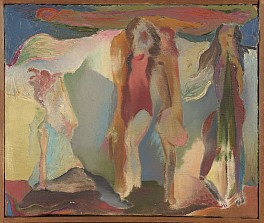
December 4, 2019 - Sarah Cascone for Artnet News
What do Elaine de Kooning, Monir Farmanfarmaian, Helen Frankenthaler, Louise Bourgeois, and Faith Ringgold have in common? They all studied at the Art Students League of New York—and they are all featured in a new show at the school highlighting the accomplishments of its many women students.
Titled “Postwar Women,” the exhibition, curated by Will Corwin, features more than 40 women who studied at the school between 1945 and 1965. “It seemed like the obvious choice because before the war, most of the women students here were wealthy or had family who supported them as artists,” Corwin told Artnet News at the exhibition’s opening. “During this period, you actually get working-class women becoming artists. And of course, you get the Abstract Expressionists.”
Corwin has put together an impressive selection of works by well-known alumna—Lee Krasner, Grace Hartigan, and Louise Nevelson are also among the big names—alongside examples by an intriguing array of artists who haven’t yet been widely recognized for their talents.
“The league’s list of famous graduates is like everybody you’ve ever heard of,” Corwin said. For him, the curatorial challenge was balancing expectations: ensuring that all the major names were in place while still creating opportunities for viewers to discover new artists.
Read More >>